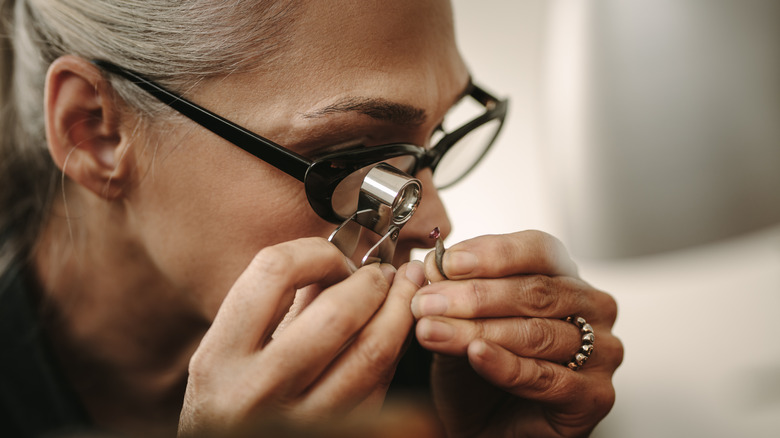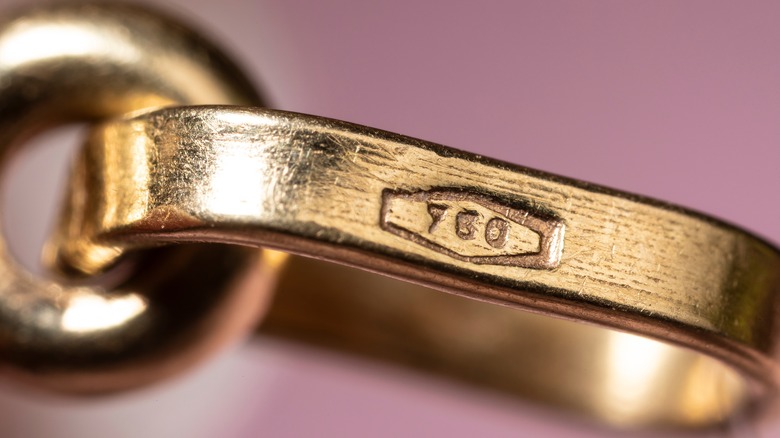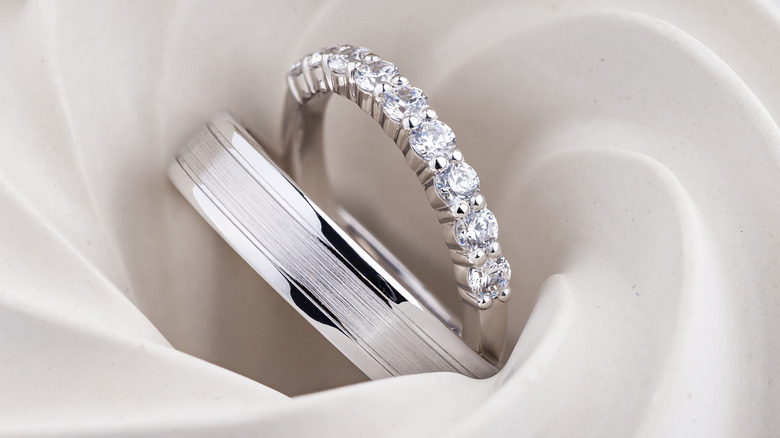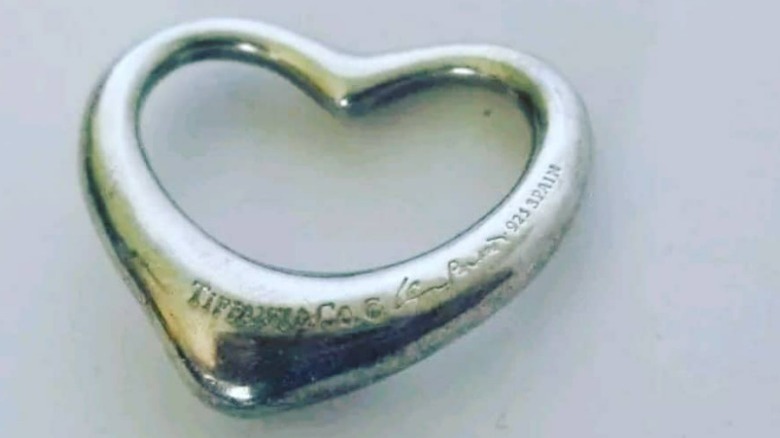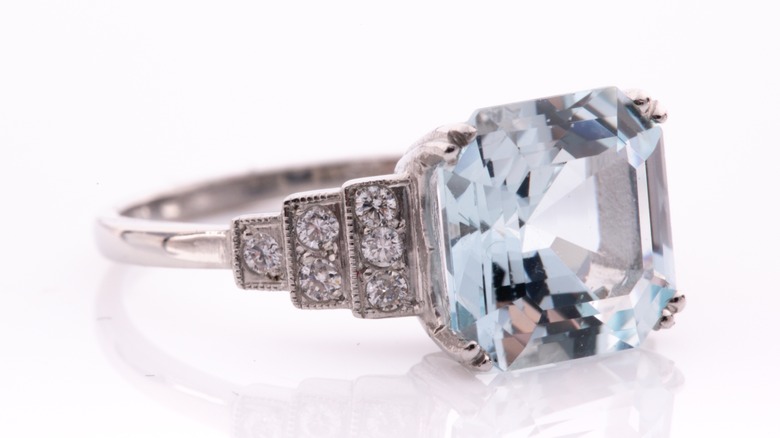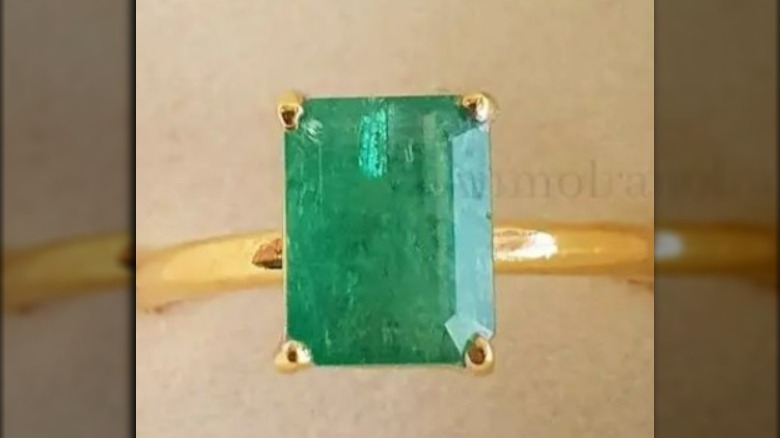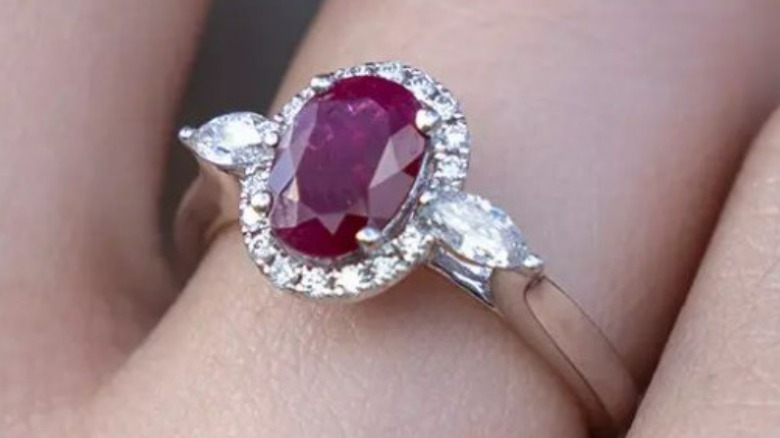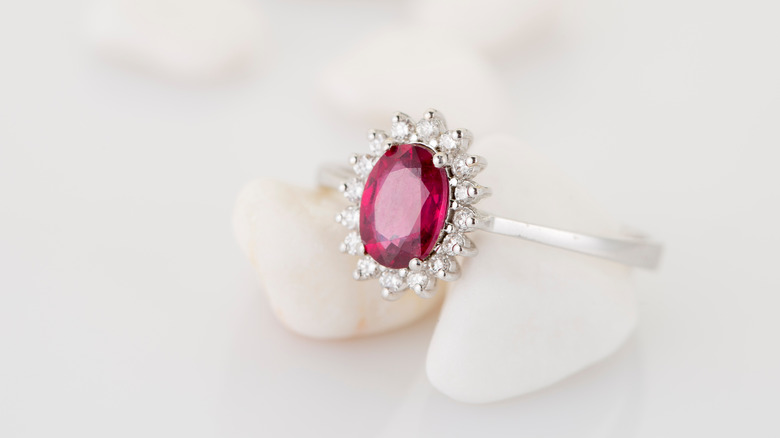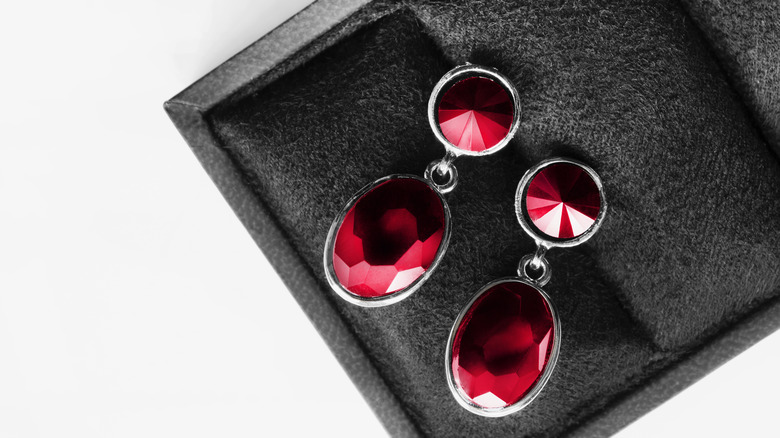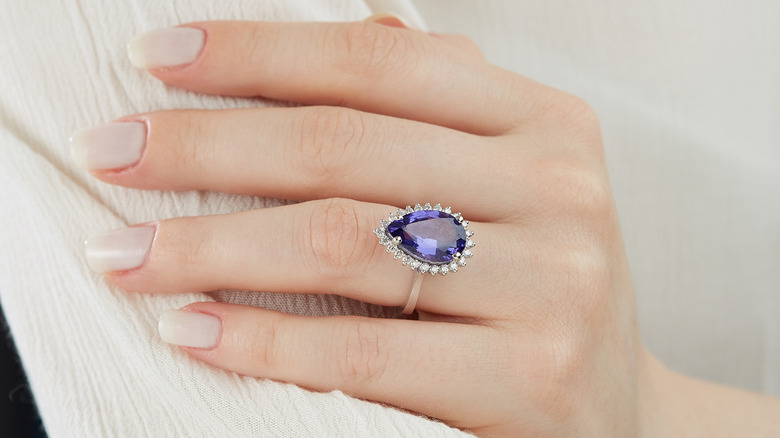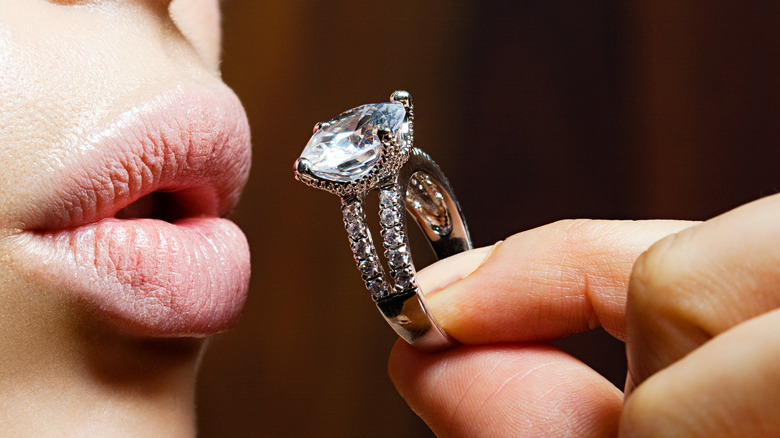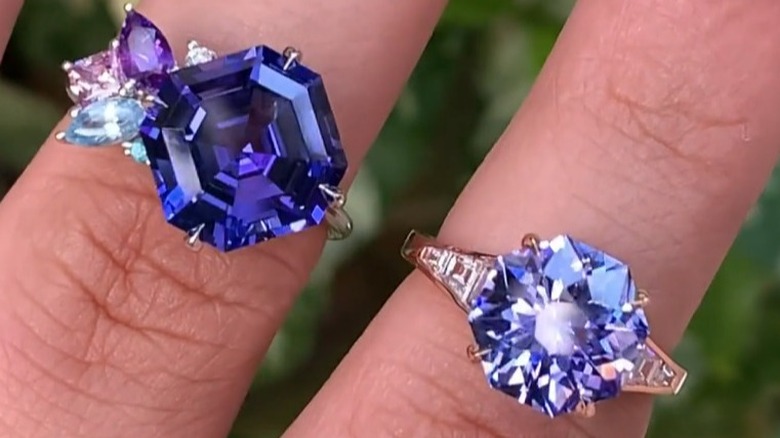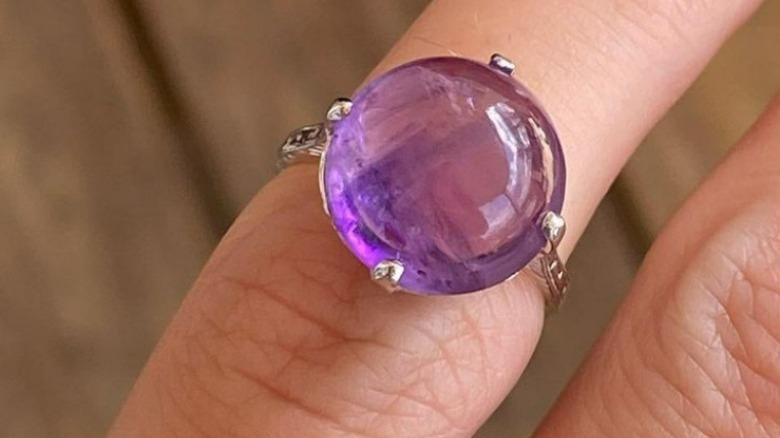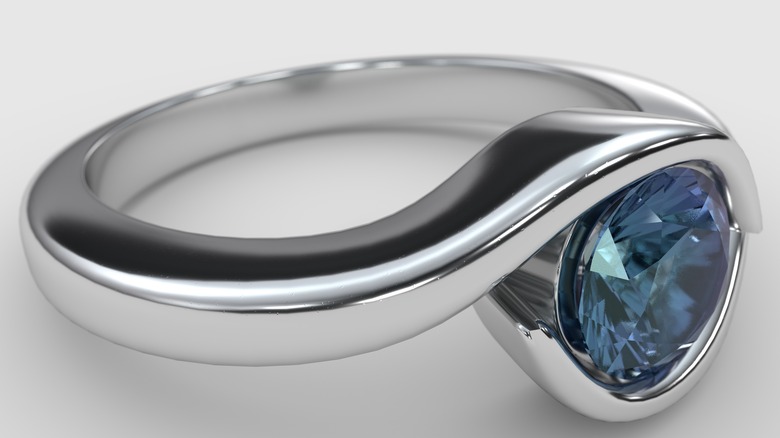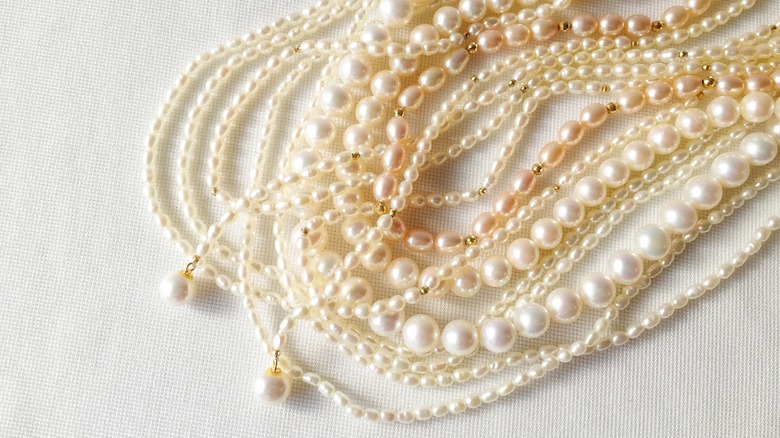Ways To Tell If Your Jewelry Is Fake Rather Than Fine
Remember that scene in 2001's "Moulin Rouge," when the diamond worn by Nicole Kidman's character, Satine, turned out to be a fake? Satine's disappointment was palpable, and who couldn't relate? It's not that there's anything wrong with costume or fashion jewelry — meaning jewelry that uses base metals and simulated stones as opposed to the fine metals and precious and semi-precious stones used in fine jewelry.
The way we see it, if it sparkles and it's pretty, we're wearing it. Indeed, some of the hottest jewelry trends right now, or at any given time, for that matter, will inevitably include costume/fashion jewelry. Not for nothing, the late Queen Elizabeth II was a fan of the iconic Emanuel Ciner's semi-precious gemstone-embellished baubles. And White Diamonds perfume creator Elizabeth Taylor was right there with her.
It's just that if you thought you were wearing a diamond and you learned it was actually made of glass, you would be disappointed. But it might also be disappointing to learn the diamond was a white sapphire, which is, itself, a precious stone with a legitimate place in the fine jewelry lineup. (And an excellent alternative choice for an engagement ring, we might add!)
Arguably, then, the difference between fine and fake jewelry resides in our expectations. Accordingly, determining whether jewelry is fine versus fake will ultimately come down to whether said jewelry is what it was described to be. And fortunately, we can help you with that.
Gold
We're starting with gold because it's where humanity's notion of "precious metals" began in the first place. Pure gold is known to be 24 karats, which means it hasn't been mixed with any other metal, per The Diamond Pro. But fine jewelry is seldom made with 24k gold because it's generally considered too soft and malleable to stand up to wear — or, worse, to hold tightly onto fine gemstones. So, perhaps surprisingly, fine gold jewelry will almost inevitably be made of an alloy of gold with another metal, often silver or copper.
The alloys that are considered "fine" are comprised of at least 41.7% gold. That's what 10k gold is, actually. 14k and 18k golds are comprised of 58.3% and 75% gold, respectively. But to be considered a fine piece of jewelry, the gold alloy must be solid — meaning that it's the same through and through, as opposed to a coating of the alloy on top of another metal (e.g., gold-plated, gold vermeil, and gold-filled).
To determine whether your gold jewelry is fine versus fake, you'll want to look for an engraved hallmark bearing the karat weight or the actual percentage of gold, expressed as a 3-digit numeral (e.g., 75% is shown as 750). But since even a hallmark can be faked, you can't go wrong dropping your gold jewelry into a glass of water to see if it floats. If it does, it's almost undoubtedly fake.
Platinum
Platinum is a harder metal than gold, which means that it's sturdier and less likely to become bent out of shape with wear. That's why platinum, rather than gold, is actually the "gold standard" for engagement ring settings. Given its hardness, platinum jewelry is considered "fine" if it's at least 50% pure. As with fine gold jewelry, fine platinum jewelry comes engraved with a hallmark that will indicate its purity (i.e. how much of the metal comprising the jewelry is actually platinum). If you don't see that hallmark, then you should assume your jewelry is fake.
As mentioned previously though, hallmarks, themselves, can be faked. What cannot be faked, however, is the magnet test. First, take off the piece and hold it loosely in the palm of one hand. Use your other hand to hold a magnet as close as you can to the metal without actually moving the metal. If you feel even the slightest "tug" in the magnet's direction, then it's almost certainly not fine platinum.
If you're still not sure, you can order an "acid scratch test" kit online. Or you can accomplish the same thing using 3%-strength hydrogen peroxide — a higher strength could potentially injure your skin. Simply immerse the piece in the H₂O₂. If you see any bubbles, then it's unlikely your jewelry is made of fine platinum.
Sterling Silver
Fine gold jewelry is frequently alloyed with silver. So, it might seem paradoxical that silver, itself, may be considered a fine metal. Of course, that's only true of what's classified as "sterling silver," which is a metal alloy comprised of 92.5% pure silver. Ironically, there is an even purer form of silver — one that is 99.9% pure, and it's actually known in the industry as "fine silver." However, it's not appropriate for use in jewelry because, like 24k gold, it's too soft.
To recognize sterling silver jewelry, you'll want to look for an engraved hallmark, "925." If your silver jewelry doesn't have that hallmark, it's likely fake. If you are still unsure, the magnet test described previously with regard to platinum works equally well for silver. Like platinum, sterling silver has no magnetic properties. Accordingly, even the slightest feeling of "pull" towards a magnet is a big red flag.
In addition, unlike gold and platinum, sterling silver tarnishes. Therefore, if your silver jewelry never becomes discolored, even after long periods of disuse, there's a good chance that it's not the real deal. In the meantime, however, you can test it by vigorously rubbing a white cloth over the metal. Real sterling silver will almost inevitably leave at least a trace of dark residue — even if the jewelry currently shows no visible signs of tarnish.
Aquamarine
Aquamarine is a nice, calming crystal that may help lower anxiety. But it also has a place in fine jewelry. Aquamarine is in the beryl family, along with emerald and red beryl, both of which are considerably rarer and significantly more expensive than aquamarine. But just because aquamarine is more reasonably priced than some other gemstones, that doesn't mean there aren't fakes posing as the real deal out there. For example, sky blue topaz — a pretty, albeit less coveted and less expensive stone — is sometimes successfully passed off as aquamarine. The same is true of blue tourmaline and blue cubic zirconia, to name a few. Additionally, glass dyed to look like aquamarine is frequently used in fabricating fake aquamarine jewelry.
Fortunately, fake aquamarine is fairly easy to discern. For one thing, real aquamarine is almost always flawless to the naked eye, meaning it's free from visible flaws, or in jeweler parlance, "inclusions." That's not true of all precious and semi-precious stones. In addition, take a good look at your aquamarine from different angles. If it's real, the color should read differently from different angles. And real aquamarine will never present with bubbles inside its facets.
If you're still in doubt, however, you can also try pressing the stone against your skin. Real aquamarine will always feel cool to the touch, whereas glass will pick up heat from your skin.
Emerald
As another member of the beryl family, the emerald is a highly prized gemstone known for its distinctively rich and true green hue. In fact, the emerald's deeply saturated color is, for some jewelers, a threshold test to determine whether a supposed emerald isn't actually some other green gemstone, such as peridot, tourmaline, or green sapphire – or worse, glass. However, color perception tends to be rather subjective, Furthermore, jewelers and jewelry appraisers have an advantage over the rest of us as discerning the fine from the fake is part of the work they do every day.
So, if you're checking your supposed emerald jewelry for authenticity at home, you might benefit from using a tool known as a Chelsea Filter. Available online from Amazon and other retailers, Chelsea Filters are priced at under $25. When viewed under a Chelsea Filter, a true emerald will actually appear red — unlike most other green gemstones.
If you don't have a Chelsea Filter, another option is to hold your gemstone up to the light to search for visible flaws. Emeralds almost always have inclusions, and they tend to be visible to the naked eye. By contrast, gemstones being passed off as emeralds may or may not, and green glass being passed off as an emerald almost certainly will not. A glass imitation may have bubbles within its facets, though.
Finally, you can tell a genuine emerald from a fake by touch; Emeralds remain cool to the touch, unlike green glass.
Red Beryl
Red beryl does not have the instant name recognition of its fancy beryl family cousin, the emerald, nor its fellow precious red gemstone, the ruby. But red beryl happens to be among the rarest of gems. The supply of red beryl is so limited, in fact, that The Natural Ruby Company (TNRC) reports that some luxury chain jewelers, including Tiffany & Co. and Cartier, are unable to source it reliably enough to include it in their regular fine jewelry collections.
So, the first thing you might want to ask yourself if you have a piece of red beryl jewelry, is where it came from. If it came in a Tiffany's box, for example, that's not a good sign. If you purchased it mail-order, that also does not bode well. If you can trace your red beryl to a jeweler you trust, then things are starting to look more hopeful. And you may be able to discern your gemstone's authenticity just by making a few simple observations.
First, if your red stone is larger than two carats, it's almost certainly a fake because a red beryl of that size is as rare as a 40-carat diamond! In fact, most faceted red beryl stones weigh in at a quarter carat or less. In addition, upon close inspection, you should be able to see small inclusions; a genuine red beryl will almost never be flawless to the naked eye.
Ruby
Unlike roses, rubies only come in red. Accordingly, a supposed ruby of any other color should be an immediate red flag. In addition, the red of a genuine ruby will almost always be a true red, although it may have pinkish or purplish flashes and undertones.
By contrast, if you see a supposed ruby that contains undertones or flashes of yellow or orange, or if it strikes you as "earthy," then it may well be a fake ruby. It could also be a real garnet, another precious gemstone, but if you were expecting a ruby, that may be disappointing.
Of course, color can be difficult to assess via the untrained eye. So, another way to tell if your red gemstone is authentically ruby is by looking for scratches on its surface. Ruby is such a hard mineral that it is very difficult to scratch. If you can scratch it with your fingernail, for example, that's a sign it's fake. Or try dragging the stone across a porcelain plate — if it leaves any colored mark at all, it's probably fake.
Finally, real rubies tend to have inclusions. Most won't be visible to the naked eye, but you may be able to detect them with a magnifying glass. If you see inclusions, that's a good sign, but they need to be consistent throughout the stone.
Garnet
Garnets are often red, which is why they may be passed off as rubies by some unscrupulous gemstone dealers. In fact, garnet is sometimes known by the derisive name, "poor man's ruby." But, as noted previously in our discussion of rubies, the red of a garnet should have some warmth to it — in the form of earthy brown, green, and orange tones. A pure red garnet is likely to be a fake. That being said, garnets also come in other colors, including black, purple, orange, and amber. In fact, garnets that are not red are rarer and more expensive than the red variety.
If you're trying to tell whether your fine jewelry bears a fake garnet, you're better off focusing not on the color itself, but on its level of saturation. A real garnet will appear deeply saturated in whatever color. A real red garnet will also be fairly free from inclusions, although the same isn't true for some of the other colors, especially orange, which is expected to have many inclusions that are visible to the naked eye.
Finally, a real garnet may not be as hard as a ruby. However, you shouldn't be able to scratch it easily.
Sapphire
Sapphires are comprised of the same mineral as rubies — corundum. But rubies get their red color from the interaction of corundum with the element chromium. And although we tend to associate sapphire with the color blue, this fine gemstone actually occurs naturally in just about every color imaginable — except red, because that would be a ruby. A sapphire's color is simply a matter of which elements the corundum in question was exposed to before it was mined.
The fact that sapphires occur in a variety of colors means that color will not be helpful in assessing whether your sapphire jewelry is fine versus fake. But like its sister, the ruby, the sapphire is a super hard mineral. Therefore, if yours shows scratches, that's a red flag. For newly acquired sapphire jewelry, you can use the same scratch test mentioned previously for diamonds and rubies. And like a fake ruby, an imposter sapphire is likely to leave behind color residue when dragged across white porcelain.
Another sign that sapphire isn't the real deal is the presence of bubbles, which suggests the stone was fabricated from glass.
A final way to tell the fine from the fake is to breathe on your sapphire and observe the ensuing fog. It should dissipate quickly, although not necessarily immediately. If it's not gone within four to five seconds, that's a strong indication your sapphire is a fake of some kind.
Diamonds
Diamonds are not only a girl's best friend, they're also the hardest material on earth — with the exception of six that aren't visible to the naked eye, per Forbes. Now, that doesn't mean a diamond won't crack or even shatter if enough direct force is applied. However, it is virtually impossible to scratch the surface of a diamond, except by using another diamond to do your dirty work. Accordingly, if you can see any scratches on your stone's surface, then it's probably fake — unless you know that you scratched it against another diamond. And that is actually an unfortunate possibility when wearing your wedding ring set.
Another way of distinguishing the fine from the fake is by examining the setting. If the metal is hallmark-bearing gold or platinum, that's a good sign because it's unlikely a reputable jeweler would mount a diamond in any other metal. Another way to test the authenticity of a supposed diamond is to breathe on it — just a light puff of air. It should fog up, but that fog should immediately dissipate. Since a diamond is so dense, it's virtually incapable of holding onto condensation.
Finally, on the off chance that your diamond is still loose (i.e., it hasn't been turned into jewelry yet), you'll know if it's real if you drop it in a glass of water and it sinks straight to the bottom. Fake diamonds float.
Tanzanite
If you happen to have — or believe that you have — a tanzanite gemstone, then you're in a very small minority of gemstone owners. Tanzanite is an extraordinarily rare gemstone that's native to Tanzania. It's prized for its unique coloration, which can range from violet-blue to blue-violet, albeit with pink or reddish undertones or flashes. Unfortunately, plain old glass is capable of being dyed to appear pretty darn close to tanzanite, and other natural minerals are sometimes treated to appear quite similar to tanzanite. Fortunately, with the aid of nothing more than a lightbulb, you should be able to tell whether your stone is a genuine article.
Real tanzanite will display different hues depending on the angle at which it's being viewed. A trichroic gem, tanzanite is comprised of three layers, and when viewed from different directions, you should be able to discern subtle differences, including the presence of bronze or gray tones. In other words, if all you see is one uniform blue-ish purplish color, regardless of the angle at which you're viewing it, then there's a good chance your Tanzanite is not the real deal.
Amethyst
Another purple gemstone, amethyst is far less rare than tanzanite. A member of the quartz family, which makes up 12% of the Earth's surface and 20% of the Earth's crust, amethyst is not even close to rare. In fact, of all the gemstones that we've been discussing thus far, amethyst is, by far, the most popular purple gem, not to mention one of the most affordable gems overall.
Amethyst is a naturally occurring semi-precious gemstone that often makes its way into fine jewelry. But just because amethyst can be acquired at a comparatively affordable price, that doesn't mean that it's immune from fabrication by the unscrupulous. Purple glass is even more common and far less costly to produce than genuine mined amethyst.
In terms of discerning the difference between fine jewelry and fake, you'll want to remember that although amethyst is, by definition, a purple stone, it will only rarely, if ever, be uniform in color. Natural amethysts will usually have what is known as "zones" of milky white and/or deep blue, and even, occasionally, pink, brown, or even red — even if those zones are fairly subtle.
So if your amethyst presents with no observable color variation, it may well be fabricated, often from glass. If it's made from glass, you also may be able to discern bubbles within its structure, especially when viewed under bright light.
Alexandrite
Mood rings, which change color depending upon ambient temperature thanks to liquid containing thermochromic crystals, are not only charming but completely on point in 2023. But there's virtually no mistaking a mood ring for fine jewelry. By contrast, alexandrite is a precious gemstone that legitimately changes color. But rather than as a function of temperature, alexandrite changes color depending upon the lighting under which it's being viewed.
When viewed in natural sunlight, alexandrite looks green. When viewed under artificial light, it can look blue, purple, red, orange, or amber. Depending on the type of artificial light, the colors may vary even more. For example, alexandrite might appear orange when viewed by candlelight. Or when viewed by the light of a longwave UV lamp, it should appear purple. No wonder the alexandrite is considered by some to be even more precious than diamonds.
Given how unusual alexandrite is and its unique appearance, it's certainly difficult to fabricate. But tip-offs include the size of the stone and the presence of inclusions. If your stone weighs more than a carat or has no discernable flaws/inclusions, then chances are it's fake.
Pearl
Unlike the other metals and gemstones we've discussed thus far, pearls are unique in that they're produced by a living organism. Specifically, pearls are the result of an irritant of some kind finding its way into the shell of an oyster (saltwater pearls) or a mussel (freshwater pearls), which reacts by coating the irritant with the same minerals that form its shell: aragonite and conchiolin.
Both saltwater and freshwater pearls are used in making fine jewelry, and both come in a variety of colors. Saltwater pearls, which are the more expensive of the two, tend to be more spherical in shape, although it would be highly unusual for any authentic pearl to be perfectly spherical. Both saltwater and freshwater pearls may be either natural or cultured, with cultured pearls being farm-raised, using actual real mollusks but in a lab setting. Unlike virtually all other synthetic gemstones, cultured pearls are not fake and most pearls sold today are cultured.
The easiest way to tell if pearls are fake is by texture. Holding a pearl between your thumb and index finger, rub it lightly against a tooth. A real pearl will feel gritty. A fake pearl will feel smooth. Further, every pearl is unique; so, if all pearls on a strand are identical, that's a red flag. Real pearls, like other genuine gemstones, will also remain cool to the touch, even when held against warm skin. Finally, a fine strand of pearls will have knots between the pearls.
